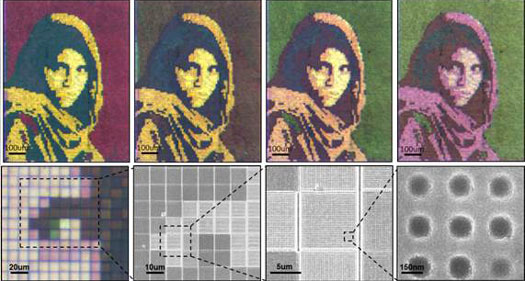| Posted: Jun 24, 2015 |
The world's first full-color, flexible skin-like display
|
|
(Nanowerk News) Imagine a soldier who can change the color and pattern of his camouflage uniform from woodland green to desert tan at will. Or an office worker who could do the same with his necktie. Is someone at the wedding reception wearing the same dress as you? No problem – switch yours to a different color in the blink of an eye.
|
|
A breakthrough in a University of Central Florida lab has brought those scenarios closer to reality. A team led by Professor Debashis Chanda of UCF’s NanoScience Technology Center and the College of Optics and Photonics (CREOL) has developed a technique for creating the world’s first full-color, flexible thin-film reflective display.
|
 |
| Microscope images of a girl image as a function of applied electric field. Nanostructure periods are chosen so colours match the original photograph at colour tuning saturation, 10 V µm-1. Scale bars: 100 µm. (© NPG)
|
|
Chanda’s research was inspired by nature. Traditional displays like those on a mobile phone require a light source, filters and a glass plates. But animals like chameleons, octopuses and squids are born with thin, flexible, color-changing displays that don’t need a light source – their skin.
|
|
“All manmade displays – LCD, LED, CRT – are rigid, brittle and bulky. But you look at an octopus, they can create color on the skin itself covering a complex body contour, and it’s stretchable and flexible,” Chanda said. “That was the motivation: Can we take some inspiration from biology and create a skin-like display?”
|
|
As detailed in the cover article of the June issue of the journal Nature Communications ("Polarization-independent actively tunable colour generation on imprinted plasmonic surfaces"), Chanda is able to change the color on an ultrathin nanostructured surface by applying voltage. The new method doesn’t need its own light source. Rather, it reflects the ambient light around it.
|
|
A thin liquid crystal layer is sandwiched over a metallic nanostructure shaped like a microscopic egg carton that absorbs some light wavelengths and reflects others. The colors reflected can be controlled by the voltage applied to the liquid crystal layer. The interaction between liquid crystal molecules and plasmon waves on the nanostructured metallic surface played the key role in generating the polarization-independent, full-color tunable display.
|
|
His method is groundbreaking. It’s a leap ahead of previous research that could produce only a limited color palette. And the display is only about few microns thick, compared to a 100-micron-thick human hair. Such an ultrathin display can be applied to flexible materials like plastics and synthetic fabrics.
|
|
The research has major implications for existing electronics like televisions, computers and mobile devices that have displays considered thin by today’s standards but monstrously bulky in comparison. But the potentially bigger impact could be whole new categories of displays that have never been thought of.
|
|
“Your camouflage, your clothing, your fashion items – all of that could change,” Chanda said. “Why would I need 50 shirts in my closet if I could change the color and pattern?”
|
|
Researchers used a simple and inexpensive nano-imprinting technique that can produce the reflective nanostructured surface over a large area.
|
|
“This is a cheap way of making displays on a flexible substrate with full-color generation,” Chanda said. “That’s a unique combination.”
|

